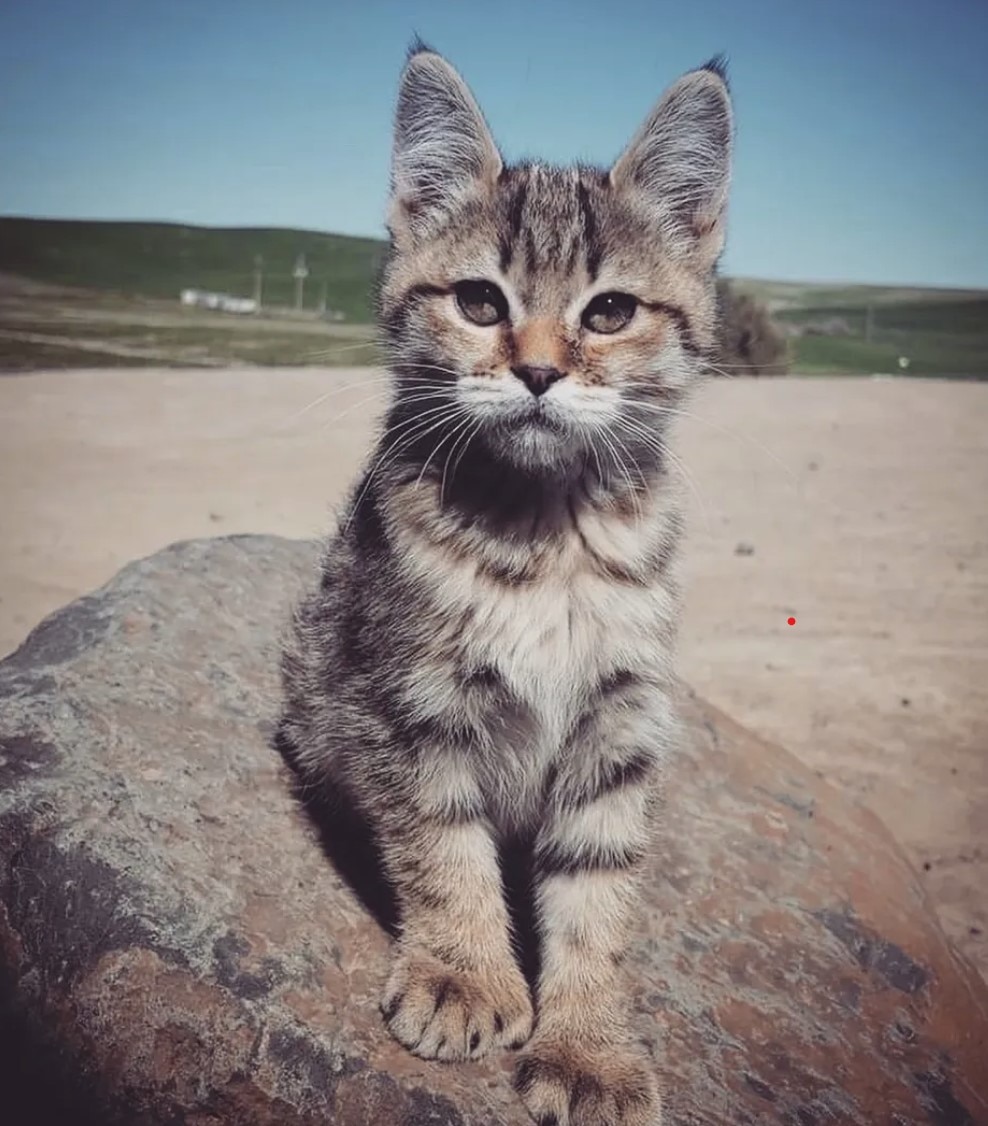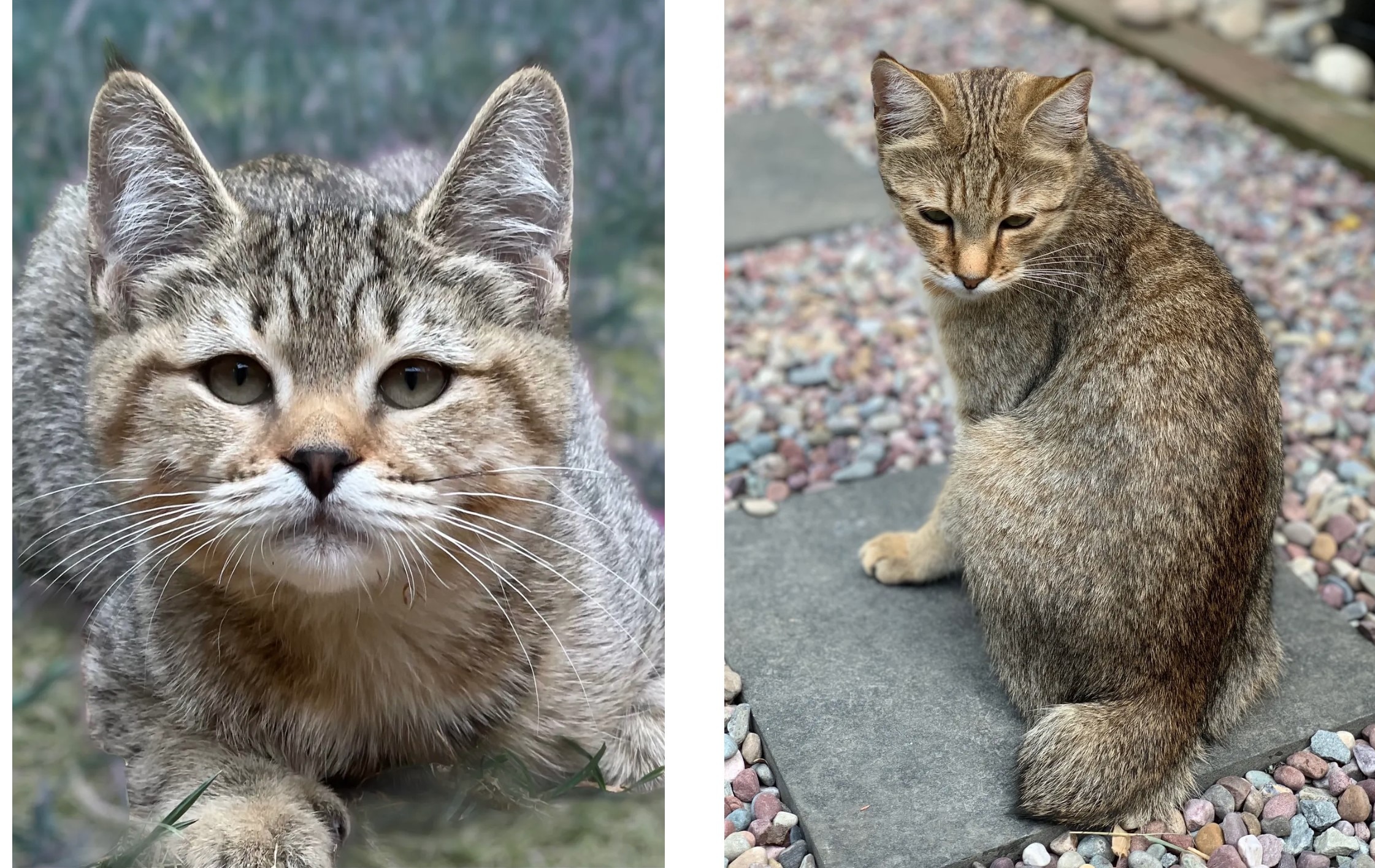Pixiebob
Pixiebobs are sturdy cats with a dog-like personality. But if you were to compare the Pixiebob to another cat, you’d find their physical appearance most closely resembles the wild coastal red bobcat found in the mountains of the Pacific Northwest. Nonetheless, they are entirely domestic cats.
Pixiebobs are medium to large in size, with distinctive lynx-tipped ears and a graceful, rolling gait, like that of a wild cat. They stand 9–13 inches tall and weigh 9–17 pounds.
Caring for a Pixiebob
Despite the rumors and their uncanny resemblance to bobcats, Pixiebob cats have no wildcat ancestry (unlike the Savannah cat breed, which is related to the African serval). They’re friendly cats dressed in a wildcat's fur: a thick, wooly double coat that feels plush and a little coarse to the touch.
Both longhair and shorthair Pixiebobs are moderate shedders; longhaired cats should be brushed a few times a week, while shorthaired cats can do with one weekly brushing.
Many Pixiebobs enjoy playing fetch, can be leash-trained for walks or hikes, and are loyal companions that love to follow their humans around. When you can't be there to provide amusement, cat trees, scratching posts, and interactive toys can offer your Pixiebob much-needed entertainment and exercise.
Pixiebob Health Issues

The Pixiebob breed was developed by Carol Ann Brewer in the 1980s. She purchased a polydactyl spotted male kitten with a short tail, and he bred with a neighbor's domestic cat. Among the kittens was a uniquely spotted female with a "wild look," named Pixie.
Enamored by her appearance, Brewer set out to create more felines with Pixie’s looks, leading to the establishment of the Pixiebob cat breed.
Thanks to the diverse gene pool that went into developing the Pixiebob breed, they’re generally healthy cats with an average lifespan of 13–15 years. But they can still be susceptible to common health concerns that affect all cats.
Obesity
Pixiebobs are not petite, but it’s still important for them to maintain a healthy weight.
Overweight cats are at an increased risk for serious health issues such as diabetes and arthritis. Unfortunately, roughly half of all cats are overweight or obese, according to the Cornell Feline Health Center.
If you're unsure how much your Pixiebob should weigh or what their body condition should look like, talk to your veterinarian. They can help you determine your cat's ideal weight and, if necessary, recommend a change in diet.
Dental Disease
All cats can develop dental disease due to plaque and tartar building up on their teeth. This can be painful for your Pixiebob and can even affect the health of certain organs.
Brushing your cat’s teeth every day is the best way to prevent dental problems. Your veterinarian will also recommend professional dental cleanings under anesthesia, as needed.
What To Feed a Pixiebob
Pixiebobs should eat commercial cat food formulated for their specific life stage: kitten, adult, or senior.
Choosing a high-quality diet that meets the Association of American Feed Control Officials (AAFCO) nutritional recommendations ensures your cat receives all the essential nutrients and vitamins they need.
How To Feed a Pixiebob
Feeding your cat from a non-plastic food bowl is perfectly fine, but you can also use an automated feeder for consistent mealtimes. (Plastics mixed with saliva in cats can cause skin issues, such as chin acne.)
Interactive options like foraging mats, puzzle feeders, and lick mats can help your cat combat boredom, may reduce anxiety, and slow down fast eaters.
How Much Should You Feed a Pixiebob?
Feed your Pixiebob measured meals twice a day. Kittens can eat more frequently—up to four times daily.
The best way to get the portions right is by asking your vet how many daily calories your cat should eat. They’ll base this number on your cat’s current and ideal weight, their age, health, and activity level.
Don’t forget to account for treats, which should make up less than 10% of a healthy cat’s daily caloric needs.
Nutritional Tips for Pixiebobs
As long as your cat is healthy and they’re eating complete and balanced cat food, they typically don’t require supplements. If you have concerns about your cat's nutrition or think they might benefit from supplements, consult your veterinarian for guidance.
Behavior and Training Tips for Pixiebobs
Pixiebob Personality and Temperament

While Pixiebobs enjoy an active lifestyle, they’re anything but wild. Pixiebobs are gentle and affectionate companions that, while playful, are also laid-back and undemanding.
In fact, rather than meowing, Pixiebobs often communicate through chirps, chatters, trills, and headbutts. Known for their social nature, they often enjoy following their human family from room to room. They tend to get along with dogs and other cats when introductions are made appropriately.
Genetics do play a role, but a cat's personality is also shaped by early socialization, proper introductions, and handling, as well as other life experiences. So while your Pixiebob may share common breed traits, unique characteristics will also shine through.
Pixiebob Behavior
Pixiebobs are often described as doglike not just for their social nature but also for their love of adventure. They are known to make great adventure cats, equally enjoying being outside on a harness and leash and the car ride getting there.
At home, Pixiebobs will often entertain themselves with climbing, playing, and exploring. To prevent unwanted behaviors like scratching furniture or counter surfing, provide plenty of opportunities for physical and mental stimulation through playtime, scratching posts, cat trees, and interactive toys.
Genetics do play a role, but a cat's personality is also shaped by early socialization, proper introductions, and handling, as well as other life experiences. So while your Pixiebob may share common breed traits, unique characteristics will also shine through.
Pixiebob Training
With an adventurous streak and love for their human companions, Pixiebobs are often eager learners. Skills such as teaching your cat their name or spot training using a clicker can come in handy if you plan to walk your cat on a harness and leash.
Even if you don't plan to take your cat outdoors, training strengthens the bond between you and your feline friend.
Fun Activities for Pixiebobs
-
Being around people and other animals
-
Watching and chirping at birds
-
Climbing cat trees
-
Exploring new spaces
-
Solving feeder puzzles
-
Cuddling
-
Clicker training
-
Walking on harness and leash
Pixiebob Grooming Guide
Pixiebobs have thick, double-coated fur, often in a tabby pattern. While they can have short or long hair, their coat is always dense and slightly coarse.
They have long, spotted belly hair that covers a prominent primordial pouch, according to the International Cat Association (TICA) Pixiebob breed standards.
Skin Care
It wouldn't be out of character for a Pixiebob to show interest in water, whether it's a fountain, bathtub, or shower. However, they generally don't require regular baths.
If you notice your cat is overgrooming, itching, or has other skin irritation or issues, schedule a checkup with your veterinarian.
Coat Care
Pixiebobs are moderate shedders. Brush longhaired Pixiebobs two to three times a week and shorthaired Pixiebobs weekly.
Eye Care
Pixiebobs have brown or gooseberry-green eyes. Any redness of the eyes, abnormal discharge, or irritation should be examined by your veterinarian.
Ear Care
Pixiebobs have tufts of fur on the tips of their ears, similar to a lynx cat. Like all cats, they can develop ear infections.
Signs of cat ear infections include pawing at the ears, head shaking, and a bad odor. If you notice any of these symptoms, see your veterinarian for treatment.
Nail Care
Pixiebobs can be polydactyl, meaning they have extra toes. While this doesn't typically cause problems, it does mean there are more nails to trim. If nails are left to grow too long, cats can experience discomfort or even develop painful ingrown nails.
Considerations for Pet Parents
Don’t be intimidated by their wild looks; Pixiebobs can be great family cats. They are friendly, easygoing, and playful.
While they require daily exercise (as all cats do), providing them with plenty of toys, cat trees, and scratching posts will keep them entertained. Regular play sessions with their people are also essential; aim for at least two 15-minute play sessions each day.
Pixiebob Cat FAQs
Are Pixiebob cats rare?
Yes, Pixiebob cats are considered a rare breed. There are only a handful of Pixiebob breeders across the U.S.
It’s important to only purchase cats and kittens from reputable breeders, rescues, and shelters, as they adhere to strict guidelines to ensure the health and well-being of their animals.
How much does a Pixiebob cat cost?
Pixiebob kittens can range from $800 to up to $4,000 for a show-quality kitten. And remember that the cost of caring for a cat extends far beyond their initial price.
How do I tell if my cat is a Pixiebob?
Pixiebobs are muscular, medium to large cats that look more like wild bobcats than domestic ones. Look for lynx-tipped ears and a spotted tabby pattern. Their fur is thick and slightly coarse. You can use an at-home cat DNA test to confirm whether your kitty is, in fact, a Pixiebob.
Featured Image: Courtesy of Brent and Janda Keenan of Emerald City Exotic Cats
